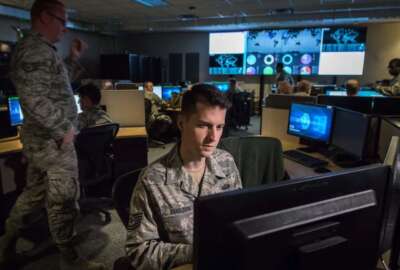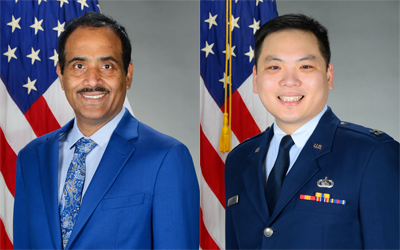Air Force Intelligence CIO finding ways to get to ‘yes’
Col. Michael Medgyessy, the CIO of Air Force Intelligence Office, is putting in IT to solve problems more quickly and drive decision making to the edge.
There may be no one facing the continued workforce and technology challenge more than Air Force’s intelligence community.
The move to new and emerging technologies like the cloud are directly clashing with the Air Force’s obligation to keep current systems running.
That is why Col. Michael Medgyessy, the chief information officer of Air Force Intelligence Office, said initiatives like the Air Force and Space Force’s Digital University are so important.
He said it’s more critical than ever to ensure his digital savvy airmen and women don’t get frustrated and leave.

“There are definitely new hires coming into the Air Force already digital savvy. They’re coders. They have a strong data understanding. And it’s this new workforce that we got to make sure it doesn’t get frustrated and leaves by enabling them to be able to do these types of things at the edge, enabling them with different technologies like low code, no code, automated workflows, being able to do scripts and things, and be able to understand that the lexicon is different,” Medgyessy said on Ask the CIO. “When do scripts become apps? When do data platforms that have user defined operational pictures on them that have names become apps that need accreditations? A lot of people will use the word app to describe a lot of different things that aren’t really, in my mind, actual, full stack applications. Then you go down these roads of, well, who’s approved this thing to be used? So enabling the workforce by ensuring that the lexicon is clear, and that they are empowered to do certain things is important.”
That also means, Medgyessy, who also is the cyber authorizing official and chief data officer for the intelligence office, said, defining user privileges and capabilities, relying on automation to help make those determinations faster and easier and protecting data and applications from intended or unintended problems.
Clearing Air Force obstacles
At the same time, by opening up these types of platforms to more airmen and women, they can solve problems more quickly, drive decision making to the edge and move faster in a secure manner.
And, Medgyessy said, “try not to frustrate them as much as possible and get them into paths that will let them use their skills and grow them.”
Limiting that frustration also means finding a way to say “yes” to new ideas. Medgyessy said he’s aware of the technology and process obstacles that can arise.
“The digital infrastructure needs to shift the mindset because every time we add new work, it’s not necessarily more cost, more resources and bodies to the person saying ‘yes,’ because the way we do this is a fully burdened cost model. So as a service, we scale elastically and the people asking for the permission to do something are coming with the funded requirement, which is actually scaling out not only the technology, but the workforce on the back end. The dynamic has shifted,” he said. “So actually, the more funded requirements we get on these capabilities, the more others can scale them out and get benefit from them. It’s a complete flip. Cybersecurity wise, we have to really take a culture and shift it from flat file repositories and reviews of those capabilities on a periodic basis into live data, and people that understand how to read code and go into the code repositories and understand where the production is getting spun up from under what policies and audits of those policies to ensure that they’re actually happening to the specifications we expect, but more so in a live manner, a dashboard manner, in a manner that understands that the production environment is in flux constantly.”
Medgyessy said his office is implementing those toolsets through continuous integration, continuous delivery (CICD) pipelines in the cloud, and leaning into reciprocity of other office’s or agency platforms.
“If we understand how a pipeline is built and the body of evidence has been approved, that they’re doing this to the specifications we also require, then those pipelines should also be able to provide a certificate that we accept and can move those containers to another environment to be able to be used without having a lot of security on top of that done, and move that in a very seamless fashion,” he said. “The only way we’re going to be able to do that at scale is not with humans, but with automation, and so our cybersecurity workforce really has to get into this world and understand it, as do the authorizing officials. The authorizing officials cannot be stuck in doing things the old industrial age way.”
Working across the community
To that end, the Air Force Intelligence Office has accepted three platforms from the National Geospatial and Intelligence Agency, the National Reconnaissance Office and from the Air Force’s Platform One. Additionally, the intelligence platform, ODIN, can bring on containerized applications from the Air Force Kessel Run and Space Force’s Gravity platforms “with very little cybersecurity rework and it’s very automated,” he said.
The access to and use of platforms is one major reason why Medgyessy said cloud office governance is a big deal for 2024.
He said with the emergence of the Joint Warfighting Cloud Capability (JWCC) vehicle and the continued use of the C2E program for the intelligence community, the governance process will help ensure users follow the guardrails the Air Force built for using cloud services.
“The shared inherited controls that you get when you using this way, the visibility and security cognizance of what’s going on in commercial cloud at any given time by the CIO is super important to trying to tame the Wild West, while not having to slow people down,” he said.. “We have to have an understanding that when you do come through the cloud office, yes, there’s going to be guardrails in place, but you’re also getting to go faster and you’re going to be more successful long term.”
That idea of going faster and being more successful also fits into Medgyessy’s goal of migrating successful agile pilots into sustainable programs.
He said the Air Force Intelligence Office is looking at moving to an “as-a-service” type of model to help get customer capabilities in place more quickly.
Air Force Intel Office to get new CDO
“We have a customer base that is larger than any normal program office’s customer base because normally that program office will have a certain finite set of users that they’re focused on. In this case, we have customer funding from all over the place, which is really been the goal for IT services. People have been wanting this forever, but we don’t actually have an institutional way to deliver what people have been wanting,” he said. “I’ll give you an example of like, we have a cost model, it’s fully burdened. So I can take customers as a multi-tenant cloud environment from anywhere and it will not cost the Air Force or the intelligence community any more money than what we were spending on supporting ourselves initially to get that capability running. But I’m scaling it out to all these customers who don’t have to duplicate the effort from scratch, and can just buy into what they need to scale it out to them. It actually helps us that model of doing business is very different.”
Medgyessy said a final priority is focused on data and improving the platform the information resides on. The good news for Medgyessy is the Air Force Intelligence Office is hiring chief data officer, for which applications closed Feb. 26. This means Medgyessy will wear one less hat.
“We have a lot of work happening with classified cloud at the edge and extending it really in two prongs. One prong is how do I get sensor data ingested into classify cloud in a low latency, high bandwidth fashion. It’s kind of like an internet of things model, where I’m doing processing at the edge, and I’m also redistributing some of that data to the regional nodes, and then bringing that back into classify cloud,” he said. “Then there’s also the data platform and how can we do replication and resynchronization when it’s reconnected across secret and top secret instances? Some of the difficulty and challenge there is regional cross domain solutions, and how we can actually move between the classifications of our data locally without having to come back to the continental United States to do it. That’s one big part there and furthering the standards for data sharing.”
Copyright © 2025 Federal News Network. All rights reserved. This website is not intended for users located within the European Economic Area.
Jason Miller is executive editor of Federal News Network and directs news coverage on the people, policy and programs of the federal government.
Follow @jmillerWFED








